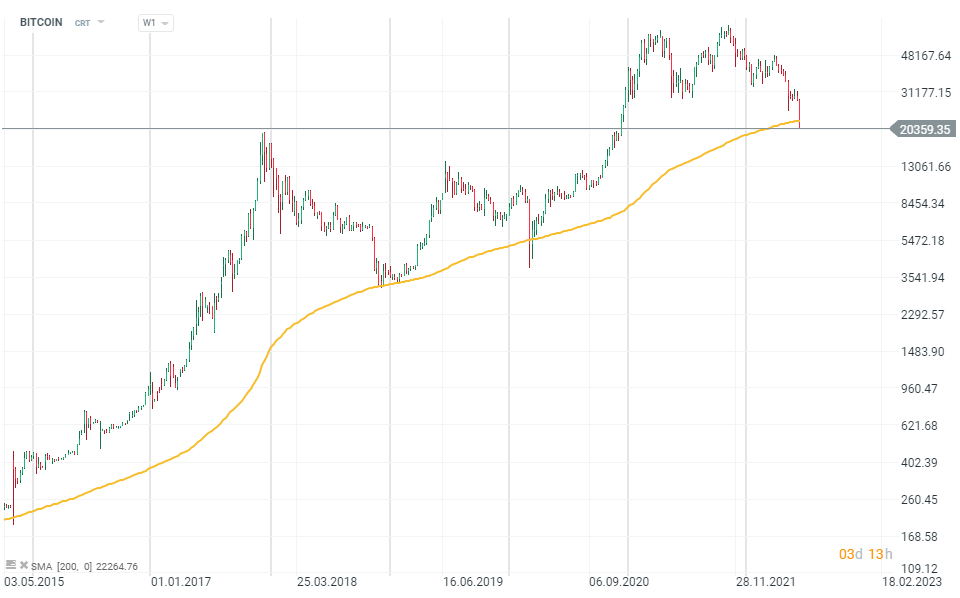Cryptocurrencies have been in a downtrend since November 2021, but recent weeks have been particularly painful for digital assets. Weak sentiment persists not only among investors focused on the cryptocurrency market, but also on stock market indices, which have had one of the weakest six months in stock market history.
What's behind the declines?
Friday's alarming data reading from the U.S. economy, which combined with already bruised market sentiment, caused an exponential sell-off on the indices, which dragged down cryptocurrencies. Record-low consumer sentiment and a surprisingly higher inflation reading from the U.S. economy raise concerns around an aggressive monetary tightening cycle by the Federal Reserve. The rise in cryptocurrencies has coincided with a period of unprecedentedly loose monetary policy and this is no coincidence. The beneficiaries of this economic environment included Bitcoin and other smaller cryptocurrencies, which are losing mightily today amid a change in central bank policy and risk aversion among investors.
The theory that Bitcoin protects against inflation, which fans of digital assets have tried to promote, so far proves to be unsubstantiated, and the limited supply of Bitcoin has proven to be an insufficient argument for the appreciation. Cryptocurrencies, as risky assets similar to tech stocks, tend to lose first when investor sentiment weakens. At the same time, however, they can make powerful gains when risk appetite grows and sentiment improves. As with stocks, cryptocurrency valuations are primarily driven by market liquidity and the price of money. Since the summer of 2020, the former was in surplus, the latter was ridiculously low. This is now reversing at a dizzying pace.
With rising inflation and uncertainty, investment opportunities for retail investors are melting away. Financial institutions are aware of this and may hold off on major cryptocurrency purchases until they are assured of an improving global economy. Panic sell-offs in the past have sometimes been buying opportunities in the cryptocurrency market. Still, there are no events on the horizon that could prompt large capital to return to the market.
Problems in the crypto market
Inflation and the price of money are not everything. Recent days have also been full of events relevant to the cryptocurrency market itself. The industry is facing a decline in confidence towards digital assets and the decentralized financial services promoted in 2021, independent of the banking system.
The crash of Luna sowed seeds of uncertainty among investors, and these have recently been fueled by problems with the Ethereum network, the suspension of withdrawals from the largest cryptocurrency exchange Binance, and the blocking of withdrawals and transfers at the decentralized financial platform Celsius. The platform offered advanced forms of so-called 'DeFi' that is, among other things, cryptocurrency loans or other forms of credit. At this moment, it seems that the project is insolvent, and this means losses going into billions of dollars. The cryptocurrency market fears intervention and a wider audit by regulators, which could potentially expose fraud and financial pyramid schemes in the DeFi space.
Investor concerns have also grown around the second largest cryptocurrency, Ethereum, whose transformation to the highly anticipated 2.0 version has once again been postponed by developers. All this combined with dire data from the economy and a sell-off in major stock market indices created a supply bomb effect that exploded in the crypto market causing massive sell-offs.
When to expect a rebound in the price of Bitcoin?
Bitcoin is a highly volatile asset, but over the past 12 years it has given investors far greater returns than the S&P500 index or the stocks of major technology companies. The cryptocurrency market is characterized by 'exaggerated reactions' and price fluctuations of several tens of percent are not unusual for its participants.
Predicting a price bottom now seems extremely difficult, as the market and macroeconomic circumstances are incomparable to previous years. Bitcoin has slipped below its 200-week moving average near $22,000, which has resulted in further price declines of tens of percent in previous cycles. Bitcoin's price has fallen as much as 85% during downturns, and this would mean a price drop in the neighborhood of $10,000. The catalyst for such a move could be the possible collapse of stablecoin Tether, whose capitalization is seven times larger than Celsius and whose fundamentals are equally questionable.
At the same time, the situation does not have to repeat itself at all; in previous cycles, the involvement of institutions in the cryptocurrency market and the general awareness of crypto market participants were small compared to today's situation. Nevertheless, if central banks signal a more hawkish approach in the conduct of monetary policy and uncertainty in the broad market fails to find a catalyst for stabilization, it could trigger further perturbations in the digital asset market.
 Bitcoin has broken multi-year support set by the 200-week moving average (SMA 200). Chart on a logarithmic scale. Source: xStation 5
Bitcoin has broken multi-year support set by the 200-week moving average (SMA 200). Chart on a logarithmic scale. Source: xStation 5
Crypto news: Bitcoin returns to gains in 2026 📈 Will the U.S. seize 600,000 BTC from Venezuela?
Daily Summary: US Indexes Slip Slightly as Year Comes to a Close
Technical Analysis: Bitcoin (31.12.2025)
Crypto news: Silver crashes, Bitcoin rebounds 📈Is crypto repeating the 2020 cycle?
The content of this report has been created by XTB S.A., with its registered office in Warsaw, at Prosta 67, 00-838 Warsaw, Poland, (KRS number 0000217580) and supervised by Polish Supervision Authority ( No. DDM-M-4021-57-1/2005). This material is a marketing communication within the meaning of Art. 24 (3) of Directive 2014/65/EU of the European Parliament and of the Council of 15 May 2014 on markets in financial instruments and amending Directive 2002/92/EC and Directive 2011/61/EU (MiFID II). Marketing communication is not an investment recommendation or information recommending or suggesting an investment strategy within the meaning of Regulation (EU) No 596/2014 of the European Parliament and of the Council of 16 April 2014 on market abuse (market abuse regulation) and repealing Directive 2003/6/EC of the European Parliament and of the Council and Commission Directives 2003/124/EC, 2003/125/EC and 2004/72/EC and Commission Delegated Regulation (EU) 2016/958 of 9 March 2016 supplementing Regulation (EU) No 596/2014 of the European Parliament and of the Council with regard to regulatory technical standards for the technical arrangements for objective presentation of investment recommendations or other information recommending or suggesting an investment strategy and for disclosure of particular interests or indications of conflicts of interest or any other advice, including in the area of investment advisory, within the meaning of the Trading in Financial Instruments Act of 29 July 2005 (i.e. Journal of Laws 2019, item 875, as amended). The marketing communication is prepared with the highest diligence, objectivity, presents the facts known to the author on the date of preparation and is devoid of any evaluation elements. The marketing communication is prepared without considering the client’s needs, his individual financial situation and does not present any investment strategy in any way. The marketing communication does not constitute an offer of sale, offering, subscription, invitation to purchase, advertisement or promotion of any financial instruments. XTB S.A. is not liable for any client’s actions or omissions, in particular for the acquisition or disposal of financial instruments, undertaken on the basis of the information contained in this marketing communication. In the event that the marketing communication contains any information about any results regarding the financial instruments indicated therein, these do not constitute any guarantee or forecast regarding the future results.


